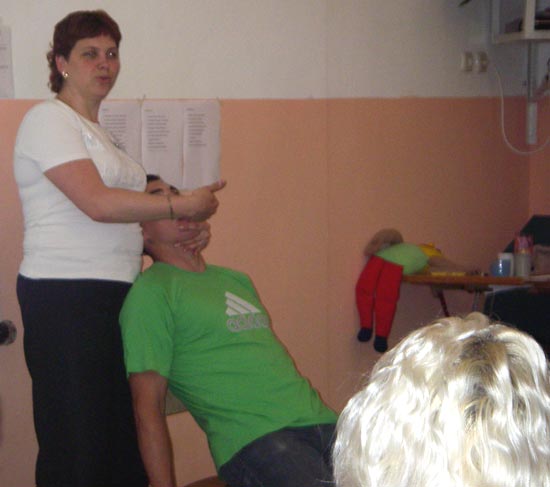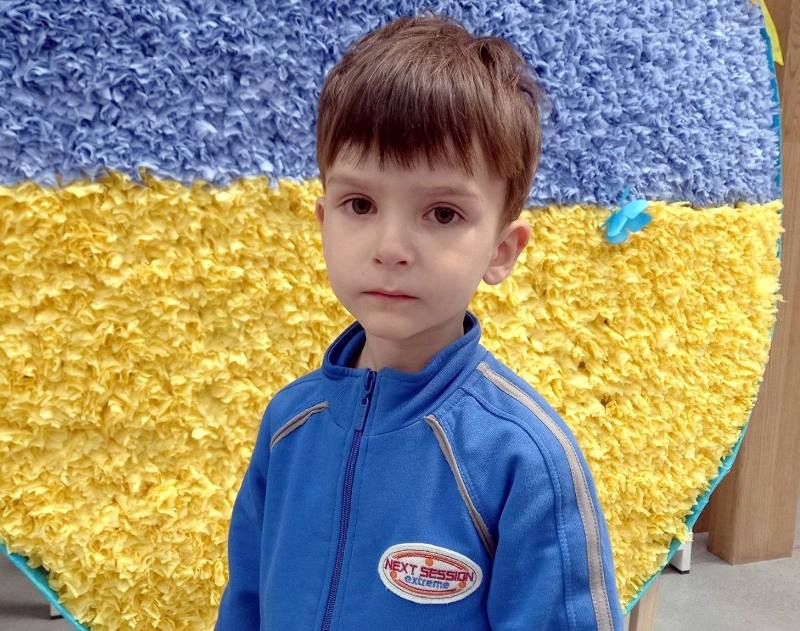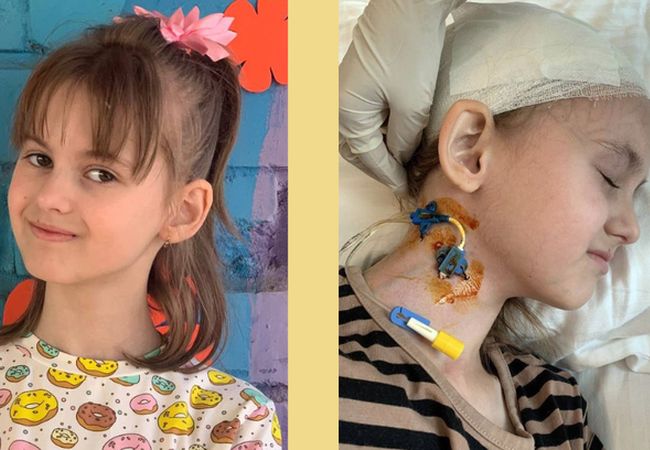
вАЬImprovement of the quality of life and standardization of care for special-needs children through the construction and development of civil society in UkraineвАЭвАФdifficult though it may be for most to understand, such is the heading for a project for special-needs kids sponsored by MATRA, a Dutch government program. (MATRA is an acronym for Maatschappelijke Transformatie, вАЬSocial Transformation.вАЭ For a full explanation of the MATRA program in Ukraine see: www.softtulip.nl).The overall project started in October 2008 under the auspices of Dutch and Ukrainian organizations as well as internat administrations and local authorities. Without the support and agreement of the latter, nothing would have been accomplished.
On 12 June 2009, with the backing of MATRA, six specialists from the state-of-the-art rehabilitation center вАЬDzhereloвАЭ (from Lviv in Western Ukraine) arrived on Zaporizhian soil with but one goal in mind: in pure Galician dialect, and with the aid of a spoon and a cover (which they insistently called вАЬkots,вАЭ вАЬrugвАЭ or вАЬcoverвАЭ in Ukrainian), they sought to improve professional standards for the personnel and volunteers on hand at the Kalinovka (Steinbach) childrenвАЩs facility. The seminar took place over four days and was called, вАЬBasic Care for Children with Serious Cognitive-Physical Disabilities.вАЭ In an easy-to-understand, graphic fashion the rehab specialists from Lviv addressed the fundamentals of care for special-needs children.
On day one, after preliminary preparation, nearly thirty members of the Kalinovka staff gathered in one of the playrooms. If the Lvivians were bit excited at the start, they were now less so, since they had already experienced a baptism of fire at two other similar internats, Ladyzhin and Znamenka.

The listeners, on the other hand, were visibly nervous, but not because this was the first such seminar in the history of the internat. The reason soon became apparent: in order to feed a family, most staff members find it necessary to keep a large household with a cow or two. After hearing that the seminar would go on for four days until 4:00 in the afternoon, these folks were simply worried about getting the cows milked.
YouвАЩll not get the cows to understand the significance of such a project, however, by mentioning impressive supporters such as the Royal Dutch Association of Physiotherapists or the вАЬNetwork of Representatives of Services for Disabled Persons SOFT Tulip,вАЭ a title that might otherwise sound appetizing to bovine ears. (SOFT = вАЬSave our Future Talents; see www.softtulip.nl.) Nor would it help to wave afresh the banner of the rehab center Dzherelo (вАЬspring,вАЭ вАЬsourceвАЭ www.dzherelocentre.org.ua; www.projekt-nadija.de), or the names of the other (national) partners of the project, namely, the National Assembly of Disabled of Ukraine (http://naiu.org.ua/) and the Ukrainian Association of PhysiotherapistsвАФnothing could relieve the slightly nervous atmosphere. However, a compromise was soon found: вАЬWeвАЩll begin the sessions earlier and reduce the breaks.вАЭ This straightforward issue proved yet again that there would be no point in grandiose, wonderful intentions (whether of authorities, professionals, volunteers, or of all the professional associations), without considering the particular conditions of life and mentality of the local community. Otherwise nothing could be changed.
We began with a little history. Lesia Kalandiak, the coordinator and leader of the project, showed photos and told about the origins of Dzherelo and how collaboration with Ukrainian internats of Levels 3-4 began (internats, like Kalinovka, for the moderate to severely disabled). Photos of daily life at the Lviv center called forth both cries of admiration as well as despair, вАЬOf course, you have everything there; three specialists for every twelve children!вАЭ The photos that followed also caused surpriseвАФwhen the participants caught sight of their own Kalinovka charges, pictures taken during an earlier program of supplementary nutrition. No one recalled (including the author of these lines) how some of the children looked just a year ago. Over the course of the year part of the children gained weight, as much as they had gained over five to seven years of their lives. It turned out that they can develop and live and not slowly die away, each day feeling quick pain at the least touch. In this case, clearly, neither the donations of the sponsors nor the efforts of the medical personnel and coordinators went to waste.
Next, we all learned the Pyramid of Needs for Special-Needs Children, applying them also to ourselves. For us, as for these children, Food, Physical Exercise, and Medical Care are necessary for happiness. After meeting all the physical requirements, we then wish for Safety and Stability. These having been secured, we seek Love and Friendship. Then we require Respect. The last step to happiness for any complete, loved, and respected human being is the requirement for Self-Improvement. ItвАЩs that simple. Once all this is applied to oneself, one realizes that it is as crucial for little Nadia, lying in her cot with her brain hernia (encephalocele), as it is for me (volunteer Ann Geraschchenko).

Further, dividing into groups, we learned to figure out from the facial expressions and behavior a childвАЩs needs and wishes. And then, most interesting, with groups seated in a small circle, we had a hands-on visit with our own patients.
Practical assignment for those reading:
1. We blindfold our eyes with a handkerchief and try to do something with our hands, or we simply stay in the room doing nothing. That simulates the situation of a blind child.
2. a. We put on heavy mittens, then one moreвАФand we try to string beads on a string.
b. Or, in a sitting position on the floor, we place our legs to one side but lean our body to the maximum to the other, not pressing our hands on the floorвАФin this position we try to assemble puzzles. That is what children feel who have motor function disability.
On the second day, our colleagues arrived at Kalinovka with cottage cheese and sour cream from local cows, not for the purpose of showing appreciation to our cordial lecturers, but for strictly educational purposes. Together with Lesia, we called to mind how and in what position a healthy child takes nourishment. Then, under the sensitive guidance of Oksana Duma, we tried to eat in the same fashion that most of the bedfast patients at the internat take their foodвАФlying down. Naturally, we did not lie down flat on the floor, but extended our heads back and in this position attempted to chew thoroughly and swallow, even if only a spoonful of delicious country cottage cheese. You yourselves may wish to try this.
After this exercise, with the aid of photos and videos, we learned how a bedfast child might receive nourishment. It might be possible to feed such a child, if placed in a special chair, out of a small teaspoon (not a tablespoon), talking with him and giving him time to swallow the food.
From theory to practice: after breaking into groups, we took three of the bedfast вАЬsucklingsвАЭ, i.e., those who feed from a bottle, and under the supervision of the physiotherapists, after placing the child in a sitting position, we tried to feed them from a spoon. The results were varied: for some this feeding was successful almost at the first try. For others, we had to suffer a good bit and be very patientвАФbut in the end it was successful for all! Day two came to an end.
Andrei Lugovskoi, a specialist for therapeutic positioning, began the third day of the seminar. We learned not only that it is necessary for a child to be given a position comfortable for him, but also periodically to change the position so that there would be no serious complications, such as there are for twenty-five year-old Anton. As much as possible, we should take a bedfast resident outdoors, even on a bed, since the patient might otherwise be lying вАЬlifelessвАЭ in bed for years on end indoors. And, indeed, Anton understands a great deal; he listens with pleasure to books about Russian epic heroes and dreams of far away trips. Unfortunately for Anton, this training seminar did not take place ten years ago.

Anton
We not only listened, but even tried out ourselves what it means to lie in an uncomfortable position.
A practical assignment for the reader: from a recumbent position, gently shift the pelvis and cross one leg, bent at the knee, over the other straightened one, and extend the head back to the maximum. If you succeed in lying in that position more than five minutes, then you are most like a level 3 or 4 patient of the internat. Normal persons begin to experience increasing head pain; halfway through, some persons will still turn their neck in hopes of вАЬputtingвАЭ it back in place. It is possible, they say, to get used to the discomfort.
A very simple exercise: simply sit down. Do not move around even when you get the urge to move. Do not move, even a little, even when the absence of movement causes distinct physical discomfort. Do not move . . .
The second part of the day was more upbeat. Marina Glukhotskaya talked about games with children. We recalled enjoyable moments of play with our own children. We considered why it is crucial to play with the bedfast residents. For a hands-on lesson we again took bedridden children and attempted to play with them. Since they requested that I not join in a group, I am able to share only my practical experience of play with little Nastya. And not just one experience but several recollections. I remember how I approached her bed for the first time a year ago. She smiled at me and eagerly pronounced вАЬMa-ma.вАЭ Up to then I had seen all of the bedfast children, but here for the first time I burst into tears. It struck me that here was a child forever doomed. A year later, I saw Nastya already reclining in a wheelchair. (Thank you, aides and teachers!) And yesterday she had progressed to the point where she was just about ready to begin to drink from a cup and eat from a spoon. Today, seated at the table, she not only began to clap hands at the sounds of a rattle but she herself began to play. In so doing, she repeated word for word what the aides told her. To be sure, the physiotherapist explained, she would not be able to remain in a sitting position the entire day, but to play with her for 10-15 minutes in such a manner minutes is entirely realistic. And you will agree, this is much better than to lie oneвАЩs entire life on a cot, bathed in the tears of strangers.

Nastya
We ended the day in a completely positive way: in groups, after receiving our assignment, we attempted to build toys for the children out of marbles, little bells, plastic bottles, and Scotch tape. We enjoyed ourselves; each person created something she was good at. This session came to an end with a sharing of the toys produced.

Day four: psychiatrist Evgenii Sukhovskii and neurologist Tatiana Mishchuk gave lectures to the medical personnel and aides on essential aspects of cerebral palsy, mental retardation, and hypotrophy.
The four-day seminar came to an end with a summing-up session and the presentation of certificates of an international type for all who passed the course of training.
We wish to give huge personal thank-yous: to Nikolai Viktorovich Slavov, director of the internat, for the colossal efforts that he made to change the daily routines and improve the childrenвАЩs lives. Also to the aides, teachers, and medical personnel, who, eyes shining, were interested in everything said and observed; to those who despite a night shift duty stuck with the seminar until the final day of training; and to all who helped with the organizing process and work during the time of the seminar.
Thank you to the specialists from Lviv. It was not the first time that the physiotherapists from Lviv had put in an appearance at Kalinovka. By contrast, even offering some compensation is not enough to induce rehab specialists from Zaporizhzhia, or from neighboring regions to come to Kalinovka.
вАЬArigatoвАЭ (вАЬCpaciboвАЭ) to Aiyami, a young woman from Tokyo, who came to look after the bedfast children. Throughout the seminar she substituted for Olga, one of the teachers, since some of OlgaвАЩs patients are no longer able to lie quietly in their beds, but loudly call for attention from gentle hands.

Aiyami
Thank you, Dima Say, who, while completing graduate studies at Tufts University (Boston, Massachusetts, USA) and without taking time for a proper vacation at home in Nikolaev (Mikolayiv), arrived at Kalinovka for the seminar on 12 June. And he remained there to work as a volunteer until 21 June.

Dima Say
Recently, it dawned on me that if you wish to get to know the most educated, modest, and selfless individuals all at the same time, a trip to Kalinovka will greatly increase your chances. It is in this context that I recall a recent acquaintance with a woman who had adopted seven children (several of whom were severely disabled), who had become interested in the fate of the Kalinovka children and inquired how she might help.
Thank you to all who helped, gave thought, showed compassion; to all who discovered this page and attempted at least one practical exercise, a concluding thought: a little participation is more important than great intentions.
Translation: David Sudermann, Northfield, Minnesota, USA



